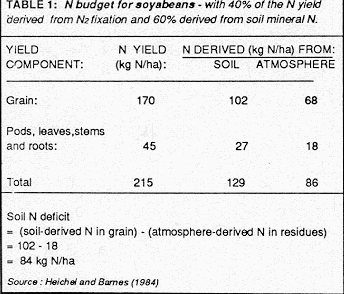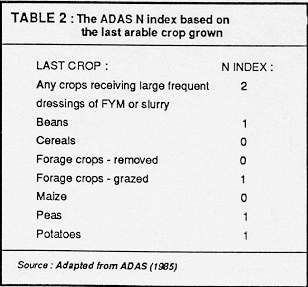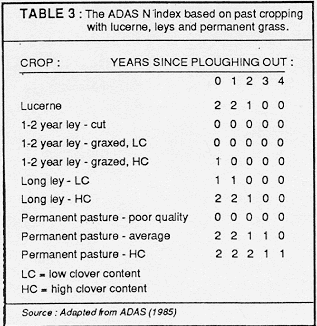

EAP Publications | Virtual Library | Magazine Rack | Search | What's new
Join the Ecological Solutions RoundtableNEW FARMER &GROWER SPRING 1989
Sustainable agricultural systems depend on the continuous fixation of atmospheric nitrogen (N2) to maintain or increase soil nitrogen (N) reserves. Whereas conventional agriculture used Inorganic N fertilizers produced by industrial N2 fixation, 'organic' systems rely on biological N2 fixation.
The most important example of biological N2 fixation is of course the symbiotic relationship between legumes and rhizobium bacteria. The legume supplies the bacteria with energy in the form of sugars, whilst in return the bacteria convert atmospheric N2 into ammonium for use by the legume.
Although bacterial N2 fixation is reasonably efficient, it still consumes more energy than the processes involved in the uptake of soil mineral N (nitrate and ammonium) by plant roots. Thus if given the choice, a legume will use available mineral N in the soil in preference to supporting N2 fixation. This is why, for example, the application of fertilizer N to legumes effectively 'inhibits' N2 fixation. Indeed with their extensive root systems legumes are very efficient mineral N scavengers, and can make effective cover crops significantly reducing winter nitrate leaching losses.
Ideally the back-bone of any 'organic' system should be the long Iey, including perennial ley legumes, like clover and lucerne. However, many 'organic' farmers will also be considering annual arable legumes, such as combine peas and field beans, as the fertility builders in their rotation - particularly with the growing interest in 'stockless systems'. But research suggests that when arable legumes are grown as cash crops, and the grain sold off the farm, soil N reserves can actually be depleted rather than supplemented.
Table 1 includes some soyabean data from the USA to illustrate how this problem can arise. In this example, when the soyabeans are harvested, the removal of soil-derived N in the grain exceeds the atmosphere-derived N in the crop residues returned to the soil. As a result there is a reduction in soil N reserves (a soil N deficit) of 84 kg/ha, even though 86 kg/ha was fixed from the atmosphere. Obviously the exact proportions of soil and atmosphere derived N in the grain and crop residues will vary, greatly according to specific circumstances;
It has long been appreciated that arable legumes are especially prone to reducing soil N reserves. This is because they only contain a small proportion (510%) of their total N content in their roots, and therefore relatively little atmosphere-derived N ever remains in the soil after harvest. Ley legumes, on the other hand, contain a much higher proportion (20-30%) of their total N in their roots and so even when cut for hay do not deplete the soil N reserves so rapidly.
No doubt this raises the question: if arable legumes can decrease soil N reserves, why do they commonly increase yields ? Prom Table 1, we see that 45 kg N/ha was returned to the soil as crop residues. These residues are of low C:N ratio and typically undergo very rapid decomposition to available soil mineral N. So even though total soil N reserves are reduced, there is still a temporary increase in mineral N available for crop uptake. These increased mineral N levels are also susceptible to leaching and denitrification losses, which can further accentuate the reduction in total soil N reserves.
Ideally, arable legumes should only be grown on the 'organic' farm as a source of protein for home mixed livestock rations. In which case, most of the soil and atmosphere derived N remains within the farm N cycle, and ultimately returns to the soil as manure. But, Iegumes such as peas and beans are attractive cash crops, and so will presumably continue to be sold off the farm. Some thought therefore, needs to be given to the management of arable legumes in the 'organic' rotation, in order to minimise their potentially adverse effects upon soil N reserves.
Two broad strategies can be identified -firstly, minimise any potential soil N deficit by specifically improving management of the arable legume; and secondly, attempt to offset possible soil N deficits by increasing N inputs at some other point in the rotation.
The main objective of arable legume management It should be to increase N2 fixation, so that a greater proportion of the legume N content is derived from the atmosphere. This effectively means that less soil-derived N is lost in the grain, and more atmosphere-derived N is returned to the soil as crop residue -thereby reducing the potential soil N deficit. For example, in Table 1 the proportion of the soyabean N content derived from the atmosphere was 40%. If this proportion was increased to 60% (ie the soil and atmosphere data in the table are reversed) then the soil N deficit is reduced to 68 - 27 - 41 kg N/ha.
The key to encouraging increased N2 fixation is to reduce the level of soil mineral N available to the legume. The basic approach to this is to grow the arable legume at a point in the ~rotation where the natural supply of mineral N is relatively low. A useful guide for this management decision is the ADAS N index.


The N index forms the basis of ADAS fertilizer N recommendations, but is also useful for the 'organic' farmer (although there is some scope for modification).The index gives rule-of-thumb estimates of mineral N supply based on previous crops and manures, and is expressed as three index Ievels - 0,1 and 2. Ideally, to encourage N2 fixation, arable legumes should only be grown when the soil is at the lowest N index (0). In mainly arable rotations the index is determined by considering the likely N residues from the previous crop only (see table 2). Residues from crops earlier in the rotation are assumed to have no N value. If there has been permanent pasture, leys or lucerne ploughed out previously, then the indices are modified to allow for the increased residual effects (see Table 3).

If the legume follows a cereal crop then the incorporation of the high C:N ration cereal straw may be used to further reduce soil mineral N levels by encouraging N immobilisation by soil microbes. Increased immobilisation after straw incorporation is well known to conventional farmers who often used to apply additional fertilizer N in the autumn to overcome any N deficiency induced in following crops. The use of incorporated straw to reduce soil N uptake is probably of greatest benefit to autumn-sown legumes such as winter beans.
A further approach to reducing soil mineral N levels whilst the legume is growing, is to inter-crop the legume with a compatible non-legume. For example, peas and barley or wheat and beans. There is some evidence that the increased competition for soil N by the cereal can lead to higher rates of N2 fixation in the legume. In addition inter-cropping has a number of other advantages for THE 'organic' farmer including pest and disease control, and weed suppression. But there is the added complication of separating legume and cereal grain before sale, particularly if there are no feed cleaning facilities on the farm.
In addition to increasing N2 fixation there is some scope for further minimising soil N ;deficits by reducing N losses from the legume residues after harvest Subsequent crops should he sown quickly after ploughing in the residues, in order to utilise as much of the released mineral N as possible. If the Iegume was intercropped with a cereal, then incorporation of the cereal straw with the legume residues should help to immobilise the released legume N, protecting it from losses such as leaching.
The easiest approach to rectifying a soil N deficit after arable legumes is to bring N onto the farm as sewage sludge, manure or compost. Assuming that these materials are readily available.
Alternatively, leguminous green manures can be used. The advantage of legumes grown as green manures is that all of the atmosphere derived N is incorporated into the soil, and no soil-derived N is removed by harvesting. For example, if the soyabeans in Table 1 had been grown as a green manure then there would have been an increase in soil N reserves of 86 kgN/ha. But leguminous green manures still need good management to be truly effective. N2 fixation can be maximised using the same guidelines as suggested above for arable legumes, but special care must be taken to minimise N losses. Much larger quantities of N are incorporated into the soil with a green manure than are incorporated after an arable legume, so there is greater potential for N loss. Although, unlike arable Iegumes, it should be possible to avoid autumn incorporation which runs the greatest risk of producing high leaching losses.
In conclusion - it is apparent That arable legumes have some limitations for the 'organic' farmer. However, they remain attractive cash crops and with careful management should have a place in the 'organic' rotation. But the moral of this tale is - do not take legumes for granted, especially arable legumes. It is all too easy to assume that a rotation is sustainable simply because it contains legumes, and this is clearly far from the truth.
Info Request | Services | Become EAP Member | Site Map
Give us your comments about the EAP site
Ecological Agriculture Projects, McGill University (Macdonald
Campus)
Ste-Anne-de-Bellevue, QC, H9X 3V9 Canada
Telephone:
(514)-398-7771
Fax:
(514)-398-7621
Email: eapinfo@macdonald.mcgill.ca
To report problems or otherwise comment on the structure of this site, send mail to the Webmaster